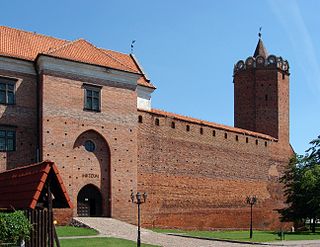
The Nowy Sącz Royal Castle is a mediaeval castle in the city of Nowy Sącz in Poland. The partially restored ruins of the castle date back to the 14th century during the reign of Casimir III the Great.

The Łęczyca Royal Castle is a medieval castle situated in Łęczyca, Poland. The castle was erected by Casimir III the Great as a fortification during 1357-1370.
The Dunajec river castles is a chain of thirteen medieval castles, built in southern Lesser Poland, along the Dunajec river. The castles protected the border between the Kingdom of Poland and the Kingdom of Hungary, as well as a very important international trade route, which went along the Dunajec and the Poprad all the way down to the Danube river. Most of the castles are in ruins now, and some have disappeared. Their history dates back to the period known as the Fragmentation of Poland in the early 12th century, when, according to his will, known as the Testament of Bolesław III Wrymouth, the country was divided into several provinces. The Dunajec river castles were located on the territory of two castellanies, Wojnicz and Nowy Sącz, in the extreme south of the Seniorate Province.

Toruń Castle or Thorn Castle is a 13th- or 14th-century castle of the Teutonic Order located in Toruń (Thorn), Poland. The Castle is part of the Medieval Town of Toruń, one of the World Heritage Sites in Poland.

The Castle of the Masovian Dukes is a Gothic castle located in Czersk, Masovian Voivodeship in Poland. The castle was built on the turning point of the fourteenth and fifteenth century.

Golub Castle is a four-wing conventional Teutonic fortress built at the turn of the fourteenth century, built on a hill as a look-out point over the whole town of Golub-Dobrzyń. The castle was initially constructed in a brick Gothic architectural style and a Renaissance attic was added in the 17th century. It is located in Golub-Dobrzyń, approximately 43km north-east of Toruń.

Uniejów Castle - one of the main places of interest in Uniejów, Łódź Voivodeship; in Poland.

Kwidzyn Castle is a large brick gothic castle in the town of Kwidzyn, Poland. It is an example of Teutonic Knights' castles architecture.

Reszel Castle is a castle located in Reszel by the bank of the river Sajna, in the south-east of the town.

Radzyń Chełmiński Castle - a castle built in a square formation; the seat of the Teutonic Knights' Commandry, located close to the Castle Lake to the north of the town of Radzyń Chełmiński. Currently partially in a ruin.

Teutonic Castle in Świecie - a partial ruin located in Świecie. The partial ruin is kept in full-shape from the bank of the river Vistula and Wda - together with a circular tower topped with merlons. The castle is part of a complex built by the Teutonic Knights in the Gothic architectural style. The castle was built on the site of a Pomeranian dukes' gord - located by the site of the castle. Formerly the castle had four corner towers, one of which survived. The castle is surrounded by a defensive wall and a moat. In 1410 the castle was looted by Polish forces obliterated the castle. The castle was owned by the Kingdom of Poland after the Second Peace of Thorn in 1466. In the sixteenth century, Castellan Konopacki reconstructed the castle into the Renaissance architectural style. The castle was devastated after the Deluge and since then was not rebuilt. The castle was furthermore devastated after Prussian forces used the castle as training grounds. Currently the castle houses a museum, with the tower and castle renovated.

Castle of Warmian Bishops in Olsztyn is a castle built in the fourteenth-century in the Gothic architectural style. The castle had the role of being the administration headquarters for the Bishops of Warmia. The most well-known administrator was Nicolaus Copernicus between 1516 and 1521. The largest expository room is the refectory with a diamond vault built around 1520. Currently, the castle houses the Museum of the Warmian-Masurian Voivodeship.

Lębork Castle - a castle built by the Teutonic Order located in Lębork, Pomeranian Voivodeship. The building is found on the river Łeba.

Olsztyn Castle – castle ruins located in the Kraków-Częstochowa Upland, lying on the Trail of the Eagles' Nests – formerly protecting the southern border of the Kingdom of Poland. The ruins of the 14th-century castle are one of the biggest attractions of the area.

Ryn Castle is a fourteenth-century castle located between Ryn and Ołów Lake, by Liberty Square in Ryn, Poland.

Drzewica Castle - a Gothic-Renaissance castle built between 1527 and 1535 by Archbishop of Gniezno Maciej Drzewicki. The Archbishop built the castle on the peripheries of the town, by the river Drzewiczka and encircled the fortress with moats, separated by a bulwark. The building's plan is based on a regular rectangular shape. Its defence systems are based on four square towers located in each corner of the castle. The building burned down in 1814, remaining a well preserved ruin. Thus, the castle did not undergo any later modifications, remaining one of Poland's best preserved residences from the first part of the sixteenth-century.

Kazimierz Dolny Castle - originating from the thirteenth and fourteenth-century, Romanesque castle ruins located in Kazimierz Dolny, Lublin Voivodeship in Poland.

Bąkowiec Castle - fourteenth-century knight's castle ruins, located in the Kraków-Częstochowa Upland. The fortress was built as part of the Trail of the Eagles' Nests defence system, located in the village of Morsko, Silesian Voivodeship in Poland.





















